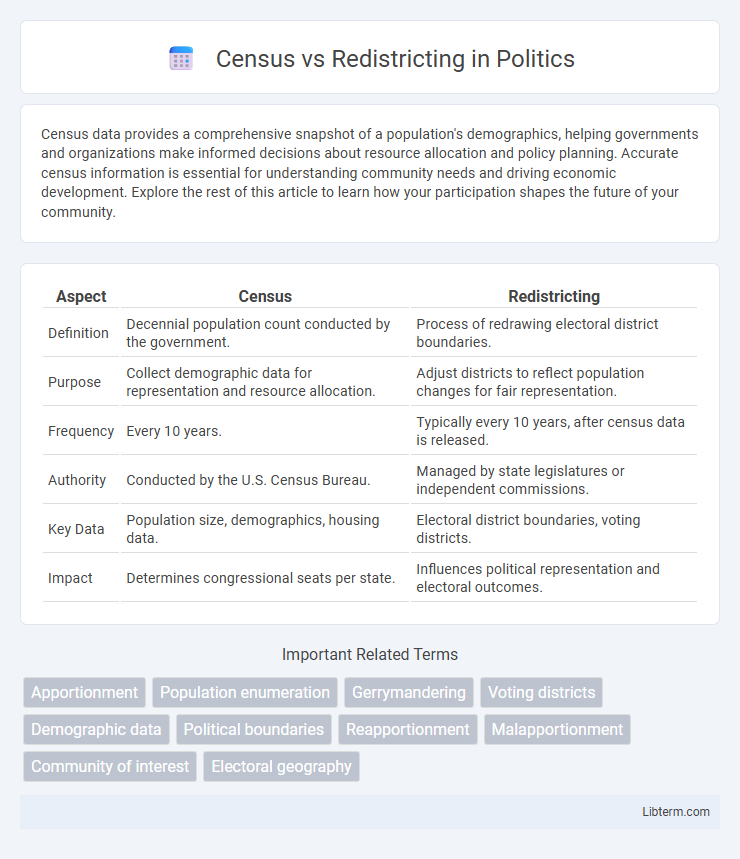Census data provides a comprehensive snapshot of a population's demographics, helping governments and organizations make informed decisions about resource allocation and policy planning. Accurate census information is essential for understanding community needs and driving economic development. Explore the rest of this article to learn how your participation shapes the future of your community.
Table of Comparison
| Aspect | Census | Redistricting |
|---|---|---|
| Definition | Decennial population count conducted by the government. | Process of redrawing electoral district boundaries. |
| Purpose | Collect demographic data for representation and resource allocation. | Adjust districts to reflect population changes for fair representation. |
| Frequency | Every 10 years. | Typically every 10 years, after census data is released. |
| Authority | Conducted by the U.S. Census Bureau. | Managed by state legislatures or independent commissions. |
| Key Data | Population size, demographics, housing data. | Electoral district boundaries, voting districts. |
| Impact | Determines congressional seats per state. | Influences political representation and electoral outcomes. |
Understanding the Census: Purpose and Process
The census is a nationwide population count conducted every ten years to gather essential demographic data used for apportioning congressional seats and distributing federal funds. It involves collecting detailed information on age, race, housing, and other vital statistics from every household to ensure accurate representation. This data serves as the foundation for redistricting efforts, which redraw electoral boundaries based on population shifts revealed by the census.
What is Redistricting? Key Definitions
Redistricting is the process of redrawing electoral district boundaries to reflect population changes captured by the decennial Census. This adjustment ensures equal representation by maintaining districts with roughly equal populations, complying with legal requirements such as the Voting Rights Act. Redistricting impacts legislative, congressional, and local government districts, shaping political power distribution for the next decade.
How Census Data Drives Redistricting
Census data provides the essential population counts and demographic details needed to redraw electoral district boundaries fairly and accurately. This data ensures equal representation by reflecting shifts in population size, density, and distribution, which influences the political landscape in local, state, and federal elections. Redistricting processes use these updated statistics to create districts that comply with legal requirements such as the Voting Rights Act and maintain balanced voter representation.
Legal Frameworks Governing Census and Redistricting
The legal frameworks governing the Census and redistricting are primarily established by the U.S. Constitution, federal statutes, and court rulings ensuring accurate population counts and equal representation. The Census is mandated under Article I, Section 2, and further regulated by Title 13 of the U.S. Code, while redistricting follows principles from landmark cases such as Reynolds v. Sims and the Voting Rights Act of 1965 to prevent gerrymandering and uphold voting rights. Both processes involve oversight from the Department of Commerce and the Justice Department to enforce compliance with legal standards for fair and equitable political boundaries.
Key Differences Between Census and Redistricting
The census is a nationwide population count conducted every ten years to collect demographic data, which serves as the foundational basis for redistricting. Redistricting is the process of redrawing political district boundaries using census data to ensure equal representation based on population shifts. While the census aggregates comprehensive demographic information, redistricting applies this data specifically to redefine electoral districts for balanced political representation.
The Role of Population Counts in Political Representation
Population counts from the decennial Census are crucial for determining political representation by providing the data needed to allocate seats in the House of Representatives among states. Redistricting uses these population figures to redraw congressional and state legislative district boundaries, ensuring each district has roughly equal population for fair representation. Accurate Census data prevents underrepresentation or overrepresentation, maintaining the principle of "one person, one vote" in the democratic process.
Census Challenges and Their Impact on Redistricting
Census challenges such as undercounts, data collection delays, and population mobility significantly affect redistricting accuracy by distorting population data used to redraw electoral boundaries. Inaccurate census data can lead to unequal representation, diluting voter power in rapidly growing or hard-to-count communities. These impacts complicate achieving fair district maps, influencing political power distribution and resource allocation for the next decade.
Redistricting Controversies: Gerrymandering and Fairness
Redistricting controversies often center on gerrymandering, where district boundaries are manipulated to favor specific political parties or groups, undermining electoral fairness. These practices can distort representation by clustering or diluting voting populations, leading to legal challenges and public outcry. Efforts to enhance fairness include independent redistricting commissions and the use of algorithmic mapping to ensure more balanced and competitive districts.
Timeline: From Census Collection to Redistricting
The timeline from census collection to redistricting typically spans about one year, starting with the decennial census conducted every ten years to gather population data. Once the Census Bureau completes data processing and releases the population counts to states--usually within nine months--states begin the redistricting process to redraw legislative and congressional district boundaries. This redistricting must comply with legal deadlines, often requiring completion before the next election cycle to ensure equal representation based on updated demographic information.
The Importance of Public Participation in Census and Redistricting
Public participation in the Census ensures accurate population data critical for fair redistricting, which directly affects political representation and resource allocation in communities. High census response rates lead to equitable legislative districts, preventing gerrymandering and promoting democratic fairness. Engaged communities influence redistricting outcomes, safeguarding citizens' voting rights and strengthening the foundation of representative government.
Census Infographic

 libterm.com
libterm.com